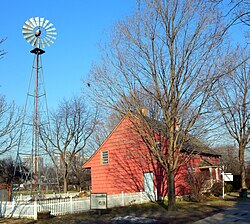Queens County Farm Museum
Cornell Farmhouse | |
 The Jacob and Catherine Adriance Farmhouse | |
| Location | 73-50 Little Neck Parkway, Queens, New York 11004 |
|---|---|
| Coordinates | 40°44′54″N 73°43′13″W / 40.74833°N 73.72028°W |
| Built | 1750 |
| Architectural style | Greek Revival, Colonial, Dutch Colonial |
| NRHP reference No. | 79001620[1] |
| Significant dates | |
| Added to NRHP | July 24, 1979 |
| Designated NYCL | November 9, 1976[2] |
The Queens County Farm Museum is located on 47 acres (190,000 m2) of the New York City neighborhoods of Floral Park and Glen Oaks in Queens. This historic farm occupies the city's largest remaining tract of undisturbed farmland (in operation since 1697), and is still a working farm today. The site features restored farm buildings from three different centuries, a greenhouse, planting fields, livestock, and various examples of vintage farm equipment. Queens Farm practices sustainable agriculture and has a four-season growing program.
The museum includes the Adriance Farmhouse which is a New York City Landmark and on the National Register of Historic Places. Free guided tours of the farmhouse are offered to the public Saturdays and Sundays year-round. Hayrides are offered on weekends (Saturday and Sunday) from April through October. An on-site seasonal farmstand featuring Queens Farm vegetables, herbs, and flowers takes place every Wednesday through Sunday (11am-3pm, Wed -Fri; 11am-5pm, Sat & Sun) from May through October.
The Cornell Farmhouse

The Cornell Farmhouse was built in 1750 with Dutch and English architectural features. The Farmhouse is in the Glen Oaks section the New York City borough of Queens. It is also known as the Creedmoor Farmhouse Complex, and as the Adriance Farmhouse. The Farmhouse is part of the museum and is owned and operated by the New York City Department of Parks.[3]
It was listed as a New York City Landmark in 1976, and on the National Register of Historic Places in 1979.[1]
History

The farm was privately owned by a Dutch family, the Adriances, from 1697 to 1808. Their three-room farmhouse, built in 1772, has been restored and still stands. After 1808, a series of families owned the farm as it continued to evolve from a colonial homestead to a modern "truck farming" or market gardening business. Under its last private farmer, Daniel Stattel, it became, by 1900, "the second largest [farm] in size in Queens County and the highest in dollar value...assessed at 32,000 dollars."[4] In 1926, the Stattels sold the farm to real estate investor Pauline Reisman, who, in turn, later that year sold it to Creedmoor State Hospital, which used it for occupational therapy, to stock its kitchen, and to grow ornamental plants for the rest of the hospital campus. In 1975, state legislation authored by Frank Padavan transferred ownership of the farm from the hospital to the New York City Department of Parks, for the purpose of starting a museum.[4]
See also
- List of museums and cultural institutions in New York City
- Open-air museum
- List of New York City Designated Landmarks in Queens
References
- ^ a b "National Register Information System". National Register of Historic Places. National Park Service. March 13, 2009.
- ^ Creedmoor (Cornell) Farmhouse (New York City Landmarks Preservation Commission; November 9, 1976)
- ^ James A. Trent (June 1976). "National Register of Historic Places Registration: Cornell Farmhouse". New York State Office of Parks, Recreation and Historic Preservation. Retrieved July 18, 2009. See also: "Accompanying six photos".
- ^ a b About the Farm: Series of Owners since 1697 (Queens County Farm Museum)
External links
- Houses on the National Register of Historic Places in New York City
- Greek Revival architecture in New York City
- Greek Revival houses in New York
- Houses completed in 1750
- Farm museums in New York
- Museums in Queens, New York
- Historic house museums in New York City
- Houses in Queens, New York
- Parks in Queens, New York
- Glen Oaks, Queens
- National Register of Historic Places in Queens County, New York





